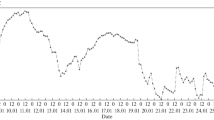Abstract—
An extended heating regulation schedule with which the heat-transfer agent thermal potential is utilized to the maximum possible extent, the required indoor temperature in the heated rooms is maintained, and the energy expenditures for heat-transfer agent transportation are kept to a minimum is studied. A new equation of relative heating load at which the required indoor air temperature is maintained taking into account heat release and heat expenditures for infiltration is considered. A new heating regime regulation equation is used and verified, which takes into account the heating load, water flowrate supplied to the heating system, the system’s nominal capacity margin, the power exponents of the heat-transfer coefficient dependences on the temperature difference and water flowrate through the system, and other factors. With using the extended schedule, the return water temperature is decreased in the heating season’s main part down to 30–40°С provided that a sufficient heating system capacity margin is available. As a result, the heat-transfer agent is cooled to a fuller extent, its flowrate is decreased, smaller energy expenditures are required for driving the heat-supply source network pumps, a smaller amount of heat is lost in the network, and more efficient operation of the combined heat and power plant is achieved. For estimating the heat-supply system’s performance, it is proposed to use the heat-transfer agent’s thermal potential utilization factor. An assessment of the effects resulting from transition of the heating systems to the extended schedule, which was carried out on a model heat-supply system for a heating season, has shown that the heat-transfer agent’s thermal potential utilization factor determined taking into account the recurrence of one-degree outdoor air temperature interval increases from 58 to 83% with such a transition, the supply water flowrate decreases from 88 to 38% of its design value, the energy expenditures for driving the network pumps are decreased by a factor of three, and the amount of heat supplied from the heat-supply source is decreased by 12.5%, or by 10.0% with taking hot-water supply into account.













Similar content being viewed by others
REFERENCES
A. A. Makarov, F. V. Veselov, A. S. Makarova, and L. V. Urvantseva, “Comprehensive assessment of Russia’s electric power industry’s technological transformation,” Therm. Eng. 66, 687–701 (2019). https://doi.org/10.1134/S0040601519100045
A. A. Pyatin, “New control model — The theoretical basis for high efficiency heating,” EKO-TEK, No. 1 (70), 15–30 (2019). http://www.energy-saving.ru/uploads/ files/eko-tek_itog_70.pdf
A. A. Pyatin, “Balanced heating — New possibilities for efficiency and energy saving,” EKO-TEK, No. 3 (68), 23–34 (2018). http://www.energy-saving.ru/uploads/ files/1-68_3.pdf
N. N. Novitskii, Z. I. Shalaginova, V. V. Tokarev, and O. A. Grebneva, “The technique of development of operational modes based on methods of multilevel thermal hydraulic modeling,” Izv. Ross. Akad. Nauk, Energ., No. 1, 12–24 (2018).
V. V. Tokarev and Z. I. Shalaginova, “Technique of multilevel adjustment calculation of the heat-hydraulic mode of the major heat supply systems with the intermediate control stages,” Therm. Eng. 63, 68–77 (2016). https://doi.org/10.1134/S0040601516010110
Z. I. Shalaginova and V. V. Tokarev, “Applied problems and methodological approaches to planning and implementation of operating conditions at district heating systems,” Therm. Eng. 66, 714–729 (2019). https://doi.org/10.1134/S0040601519100057
E. Ya. Sokolov, District Heating and Heat Networks (Mosk. Energ. Inst., Moscow, 2001) [in Russian].
V. I. Sharapov and P. V. Rotov, Load Control of Heat Supply Systems (Nov. Teplosnabzh., Moscow, 2007) [in Russian].
Y. Wang, S. You, H. Zhang, W. Zheng, X. Zheng, and Q. Miao, “Hydraulic performance optimization of meshed district heating network with multiple heat sources,” Energy 126, 603–621 (2017). https://doi.org/10.1016/j.energy.2017.03.044
E. Guelpa, C. Toro, A. Sciacovelli, R. Melli, E. Sciubba, and V. Verda, “Optimal operation of large district heating networks through fast fluid-dynamic simulation,” Energy 102, 586–595 (2016). https://doi.org/10.1016/j.energy.2016.02.058
M. Vesterlund, A. Toffolo, and J. Dahl, “Optimization of multi-source complex district heating network, a case study,” Energy 126, 53–63 (2017). https://doi.org/10.1016/j.energy.2017.03.018
E. Guelpa, A. Sciacovelli, and V. Verda, “Thermo-fluid dynamic model of large district heating networks for the analysis of primary energy savings,” Energy 184, 34–44 (2019). https://doi.org/10.1016/j.energy.2017.07.177
A. A. Bischi, L. Taccari, E. Martelli, E. Amaldi, G. Manzolini, P. Silva, S. Campanari, and E. Macchi, “A detailed MILP optimization model for combined cooling, heat and power system operation planning,” Energy 74, 12–26 (2014). https://doi.org/10.1016/j.energy.2014.02.042
MDS 41-4.2000. Method for the Determination of Quantity of Thermal Energy and Heat Transfer Agent in Public Piped Hot Water Heat Supply Systems (Gosstroi Rossii, Moscow, 2000).
V. I. Manyuk, Ya. I. Kiplinskii, E. B. Khizh, A. I. Manyuk, and V. K. Il’in, Adjustment and Operation of Water Heating Networks: Handbook (Stroiizdat, Moscow, 1988) [in Russian].
SP 50.13330.2012. Thermal Protection of Buildings (Minregion Rossii, Moscow, 2012).
SP 131.13330.2012. Climatology of Building (Minstroi Rossii, Moscow, 2015).
On the Provision of Utilities to the Owners and Users of Premises in Apartment Buildings and Residential Buildings, RF Government Decree No. 354 of May 6, 2011 (June 29, 2020 Edition).
SP 60.13330.2012. Heating, Ventilation and Air Conditioning (Minregion Rossii, Moscow, 2012).
GOST 30494-2011. Residential and Public Buildings. Microclimate Parameters for Indoor Enclosures (Standartinform, Moscow, 2013).
Letter of the Ministry of Construction, Housing and Utilities of the Russian Federation No. 40222-ACh/04 of November 29, 2016 (Minstroi Rossii, Moscow, 2016).
A. N. Skanavi and L. M. Makhov, Heating: Textbook (ASV, Moscow, 2002) [in Russian].
Updated Heat Supply Scheme of Kirov for the Period until 2035. http://www.mo-kirov.ru/gorozhanam/zhkh/ skhema-teplosnabzheniya/
Author information
Authors and Affiliations
Corresponding author
Additional information
Translated by V. Filatov
Rights and permissions
About this article
Cite this article
Pyatin, A.A., Suvorov, D.M. An Extended Heating Regulation Schedule: Definition and Assessment of Its Efficiency in Heat-Supply Systems. Therm. Eng. 68, 310–323 (2021). https://doi.org/10.1134/S0040601521040066
Received:
Revised:
Accepted:
Published:
Issue Date:
DOI: https://doi.org/10.1134/S0040601521040066




